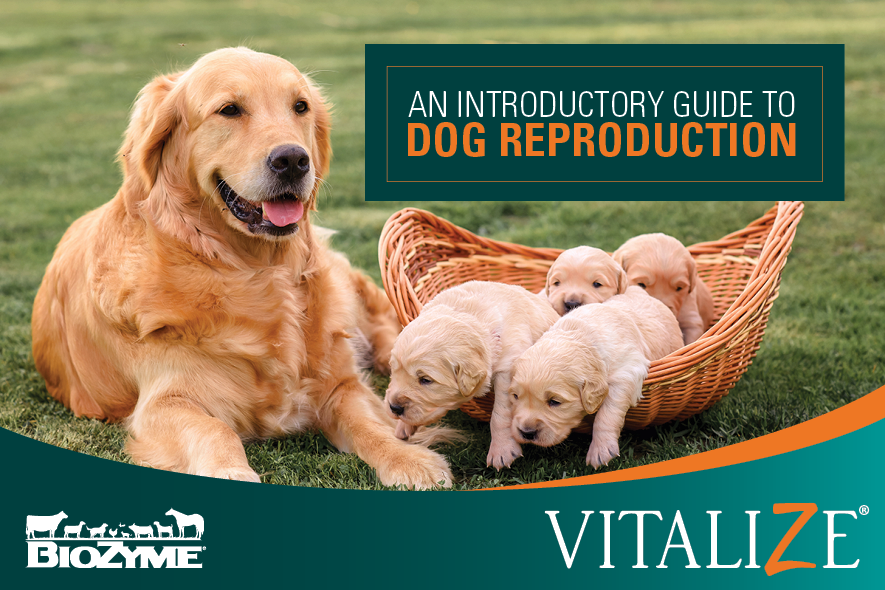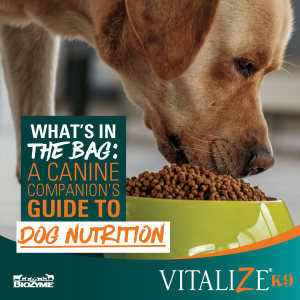
Dog Reproduction
At BioZyme®, we encompass care that comes full circle for all animals. That means caring for the animals that provide food and fiber to feed and clothe the world. It means caring for the animals that are beside our sides as faithful companions. And, of course, caring for the animals that live on the land.
We are especially passionate about dogs. They provide companionship, they are athletes, and they are workers around the farm or ranch. Dogs become service animals for those in need. They become part of our families.
It’s no wonder that so many people are passionate about breeding dogs. Who wouldn’t want to help spread that connection to others? Many Vitalize customers are interested in dog breeding, but don’t know where to start. That is why our team has created a blog to delve into all things dog reproduction.
Dog Reproduction 101
Understanding dog reproduction is important for dog owners, breeders and anyone involved in canine breeding programs. There is a lot to know about dog reproduction to ensure healthy matings and thriving litters.
We designed this piece for the beginner dog breeder; however, even the more experienced dog owner can benefit from some of this information. Here is some information you need to be aware of if considering breeding your dog.
Reproductive Anatomy
Dogs have a reproductive anatomy similar to other mammals, including male and female reproductive organs. Male dogs (studs) have testes, which produce sperm and a penis for mating. Female dogs (bitches) have ovaries, which produce eggs (ova) and a uterus for carrying embryos during pregnancy.
Dog Reproduction & Mating
Mating between a male and female dog typically occurs during the estrus stage of the female’s estrous cycle. Successful mating involves the introduction of the male’s sperm into the female’s reproductive tract, where fertilization of the eggs may occur.
Estrous Cycle
Female dogs have an estrous cycle, also known as the heat cycle or season, during which they are receptive to mating. When your dog first comes into estrous or heat, she will start bleeding. Do not panic. This is natural. It is a good idea to have a diaper on hand for her, especially if you keep her in the house. Other signs of heat include a swollen vulva and enlarged nipples.
The estrous cycle consists of four stages:
- Proestrus – marked by the start of bleeding; lasts about 10 days. Males will show interest, but most females will move them away because they know they are not ready.
- Estrus – bleeding tapers; lasts about 5 to 10 days. Ovulation begins (eggs released), and both the male and female become receptive to breeding.
- Diestrus – immediately after estrus; the female is no longer receptive to mating. Progesterone, the pregnancy maintenance hormone, increases during this stage.
- Anestrus – a stage of internal repair, either after heat or after giving birth. Progesterone levels decrease.
The length of the estrous cycle varies among individual dogs and breeds but typically lasts between 2 to 4 weeks.
Dogs will typically come into heat every 6 months; however, this varies by dog and by breed. Some larger breeds only come into heat once a year. If you are not sure about your female, consult your veterinarian or another seasoned dog breeder.
Ovulation
Ovulation, the release of eggs from the ovaries, occurs during the estrus stage of the estrous cycle when the female is receptive to mating. The timing for ovulation can vary for dogs but generally occurs around the middle of the estrus period.
Pregnancy
If fertilization occurs, the fertilized eggs (zygotes) travel to the uterus and implant into the uterine lining, initiating pregnancy. Dog pregnancy typically lasts around 63 days, or approximately 9 weeks, from the time of ovulation to parturition (birth).
Gestation & Development
During pregnancy, the developing embryos undergo rapid growth and development within the uterus. The gestation period is divided into trimesters, with specific milestones and changes occurring throughout each trimester.
Breeding & Ethical Considerations
Responsible dog breeding involves careful consideration of various factors, including:
- breed standards
- health screening
- genetic testing
- temperament
- compatibility between mating pairs
These ethical breeding practices aim to improve breed quality, health and temperament while minimizing the risk of hereditary diseases or genetic disorders. Consider the ethical implications of breeding and prioritize the welfare of the dogs and puppies involved. Avoid practices such as excessive inbreeding, puppy mills or irresponsible breeding for profit.
Health & Reproductive Management
Maintaining optimal health and reproductive management is essential for breeding dogs. This includes regular veterinary care, health screenings, vaccination, parasite control, nutrition and environmental management to support reproductive health and fertility.
Breeding Regulations
Dog breeding may be subject to regulations and laws imposed by local authorities, breed clubs and animal welfare organizations. It’s important to familiarize yourself with applicable regulations, licensing requirements and other guidelines for breeding dogs in your area.
Now that our team has provided basic information about dog reproduction, lets examine the importance of reproductive health in your canine companions and why it is important for successful matings.
Dog Reproduction Health Priorities
The most important thing about dog reproductive health is responsible breeding practices. Responsible breeding involves ensuring the health, welfare and well-being of both the male and female dogs, as well as the puppies they produce. Here are some key aspects of responsible dog reproduction and reproductive health:
Health Screening & Reproductive Soundness
Before breeding, both the male and female dogs should undergo thorough health screenings by a veterinarian. This includes testing for genetic disorders, screening for hereditary conditions common to the breed and evaluating overall health and fertility. Genetic testing can identify potential inherited health issues in breeding dogs, allowing breeders to make informed decisions to minimize the risk of passing on genetic diseases to offspring.
Additionally, ask the vet to assess the reproductive soundness of both male and female dogs, including evaluating fertility, reproductive anatomy, and overall reproductive health. Consult with a veterinarian experienced in reproductive medicine if necessary.
Breeding Age & Frequency
Dogs should only be bred once they have reached maturity and are in optimal health. Breeding females should be given adequate time between litters to recover and regain their health. Breeding a female too often or overbreeding can lead to health problems for both the female and her offspring.
Nutrition & Care
Proper nutrition and care are essential for reproductive health. Ensure breeding dogs receive a balanced diet, appropriate exercise and regular veterinary care to support their overall health and fertility.
One way you can provide extra nutritional care is providing your dogs, Vitalize, a line of supplements for dogs with proven solutions to keep your animal healthy and performing.
Vitalize® Dog is a granular vitamin and mineral supplement for dogs designed to support breeding and performance. It contains AO-Biotics® Amaferm®, a prebiotic research-proven to enhance digestibility, omegas for healthy skin and hair and a high-quality blend of vitamins and minerals for daily support of any diet.
Stud Selection
When choosing a stud dog for breeding, consider factors such as temperament, conformation, health and genetic background. Selecting a healthy and genetically suitable mate can help produce healthy and genetically diverse offspring. Remember, the stud passes on 50% of the traits to the puppies, and you want to have successful litters.
Whelping & Post-Natal Care
But the ultimate goal of dog reproduction is, of course, breeding. Namely, bringing new puppies into the world. That’s why we’ve included this brief section about considerations and strategies for whelping and post-natal care.
Whelping
Whelping refers to the process of giving birth to puppies. Signs of impending whelping include nesting behavior, restlessness, panting and a drop in body temperature. Whelping should ideally occur in a clean, quiet and comfortable environment, with minimal stress for the mother. Monitor the mother and newborns closely for signs of complications and provide necessary veterinary assistance if needed.
Newborn Care
Newborn puppies require care and attention to ensure their health and well-being. Key aspects of newborn care include providing warmth, stimulating breathing and nursing reflexes, ensuring adequate nutrition and monitoring for signs of illness or distress.
Early socialization and handling of puppies are important for their behavioral development and overall well-being. Expose puppies to various stimuli, environments and social interactions from a young age to promote positive socialization and adaptability.
Responsible Placement
Responsible breeders should carefully screen potential puppy buyers and provide guidance and support throughout the lifetime of the puppy. Ensure puppies are placed in suitable homes with owners committed to their care, training and well-being.
More about the Vitalize Difference
In addition to Vitalize Dog, the Vitalize line carries other products powered by Amaferm to give your dog a #goodgutfeeling. Why is that important?
We know that 70% of the immune response is found in the gut, so if you keep your dog’s gut healthy, it’s overall health should be in stellar condition, too. That is why providing products with Amaferm is so important to us. Research shows that Amaferm increases digestibility.
Further canine studies show that dogs that have been fed Amaferm experience fewer stillbirths produce larger litters, and wean more puppies.
We Make Safe, Accurate Products
At BioZyme, “safe accurate products” isn’t just a slogan, it’s the cornerstone of how we do business. We don’t just talk the talk, we walk the walk. And we would never put a product to market we wouldn’t give to our own pets.
Our own Senior Manager of Commercial Marketing, Lori Lawrence, has been breeding Corgis for more than 16 years. She confirms that since she started feeding Vitalize Dog, she has seen what the research suggests.
“Since I started feeding Vitalize Dog, my girls have averaged 2 more puppies per litter. Our biggest litter used to be 8. Now we are having litters of 10, and that’s a lot of puppies for a small breed. Plus, the pups come out with a lot more vigor. I feel like the increased litter size with more vigor is a great combination,” Lawrence said.
Our employees use and trust these products. Once you try them, we’re confident you will too!
Other Vitalize Products
As we mentioned, we do have other Vitalize products available for your dog’s gut health including the following:
Vitalize® Alimend® K9
Vitalize Alimend K9 is a liquid product for dogs designed to support gastric health and GI tissue and which may relieve occasional gastric issues. In addition to Amaferm, it contains MHB3®, a patented high molecular weight hyaluronic acid that coats the stomach and supports GI tissue integrity. It also contains beta-glucans to support the gut and immune system.
Vitalize® Dog Gel
Vitalize Dog Gel is a prebiotic and nutrient-rich gel for dogs. It immediately supports the digestive and immune systems. It contains Amaferm and MOS to help normalize gut microflora and the immune system. The Gel works fast to support appetite and hydration.
Get your Vitalize Today!
Help your dog stay healthy and help ensure dog reproduction success by getting your Vitalize today. We have made purchasing Vitalize as easy as possible.
You can visit your local dealer to purchase Vitalize products. Locate a dealer near you, today.
Perhaps you prefer the convenience of online shopping. Well, you can shop online, and have the Vitalize delivered right to your front door.
Sign Up for Our Newsletter
Want to learn more about other ways to take care of your furry friends? Visit the Vitalize blog today and sign up for our electronic newsletter.

